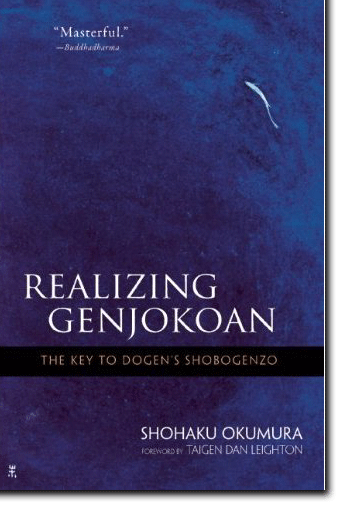
by Shohaku Okumura
Wisdom Publications, 2010, 296 pp, including Foreword by Taigen Dan Leighton, appendices, notes, glossary and index
reviewed by Vladimir K.
An ancient Buddha said, “Mountains are mountains, waters are waters.” These words do not mean mountains are mountains; they mean mountains are mountains.[5]Professor Carl W. Bielefeldt, an expert on Dōgen, has said,
So an entire book dedicated to explicating one of Dōgen’s most important works in the Shōbōgenzō is a welcome addition to the ever-growing corpus of writings on Dōgen.Dōgen thought about a lot of things, and what he thought is often very hard to grasp. I myself have no idea what he thought about many things and only a vague sense of what he thought about most of the rest. Many things he wrote I haven’t read yet; many things I’ve tried to read I can’t figure out; many things I’ve figured out how to read I still don’t understand.[6]
Those who have not yet left home life behind do not succeed to the inheritance of the Right Action of the Buddha’s Dharma. They have not received the authentic Transmission of the Great Course of the Buddha’s Dharma…. Whenever anyone has become expert in the Way, that person has invariably left home life behind. How can those folks who are not up to leaving home life behind possibly devote themselves to attaining the rank of Buddha?[8]
It is fortunate for us that Genjōkōan emerged early in Dōgen’s teaching career as perhaps it may not have been written later, when he believed only monks could attain the Way.
Okumura has done a remarkable job in clarifying Dōgen for anyone who is interested in Zen Buddhism. He begins by briefly outlining Dōgen’s life and in Chapter 2, the meaning of the word “genjōkōan”. The expression appears twenty-five times in Shōbōgenzō while the word “genjō” is used over three hundred times so the meaning of these words is quite important when studying Dōgen. Okumura takes apart the kanji characters to explain how the word genjōkōan is constructed, concluding that in English, genjōkōan means “to answer the question from true reality through the practice of our everyday activity.” (p. 21)

This meticulous analysis is typical of the rest of the book. Each section, sometimes each sentence, is taken apart and studied in detail. Okumura reveals not only Dōgen’s intention in many parts of the text, but also the background to Dōgen’s thinking and, in some cases, the source of an expression or metaphor. This background material built into Okumura’s commentary provides a knowledge base which is most useful in penetrating Dōgen’s thoughts. For example, perhaps the most famous expression in Dōgen’s writing, “dropping off body and mind”, is analyzed by looking at conversations between Dōgen and his Chinese teacher, Tiantong Rujing (1163-1228) as recorded by Dōgen himself in Hōkyōki (Record in the Hōkyō Era). Okumura then looks at the Japanese expression, shinjin-datsuraku, and, as he did with the word genjōkōan, takes it apart to study the constituents of the phrase. Then he looks at what the word means in the context of Zen practice. Such a detailed explanation of a key Dōgen phrase is most useful in furthering our understanding of Dōgen’s teachings.
Along with the commentary, there is of course a full translation of text by Shohaku Okumura. Of all the texts found in Shōbōgenzō, Genjōkōan is probably the most often translated and there are many versions available.[9] There are also three appendices: a translation of Maka Hannya Haramita Shin Gyo, the Heart of Great Perfect Wisdom Sutra; Dōgen’s commentary on the Heart Sutra, Shōbōgenzō Maka Hannya Haramitsu, and chapter two of Hee-jin Kim’s classic work, Eihei Dōgen — Mystical Realist, which is a biography of Dōgen’s life. Furthermore, there is a foreword by Taigen Dan Leighton, a bibliography, a glossary, notes and an index.
This book is a welcome addition to the growing library on Dōgen and his teaching. It reveals Okumura’s extraordinary understanding of Dōgen and is written with great sensitivity and compassion. For example, I was appreciative of the fact that although Okumura comes from a Japanese background, he maintains the Chinese names of the Chinese masters, using the pinyin system of nomenclature. It is long overdue for writers in English to recognize that there is no need to use the Japanese forms for Chinese names, regardless of the background of the author. It is culturally insensitive and quite unnecessary to usurp Chinese names and express them in the Japanese form.
Okumura is not just an expert on Dōgen, he is also an excellent teacher and both novices and seasoned practitioners would benefit by reading this book. While Genjōkōan is, as the subtitle of this book notes, the key to Dōgen’s Shōbōgenzō, Okumura provides us with a key to unlocking much of Dōgen’s teaching. I heartily recommend this book.
Notes
References
Moon in a Dewdrop: Zen Master Dōgen, (1988), K. Tanahashi, ed., Element Books, Longmead
Eihei Dōgen: Mystical Realist, Revised, Third Edition, (1975). Hee-jin Kim, Wisdom Pub., 2004
Rational Zen: The Mind of Dogen Zenji, (1993), translated & edited by Thomas Cleary, Shambhala, Boston & London
Further Reading
for a free complete copy of Shōbōgenzō as well as translations of individual essays, see my Dogen Teachings page